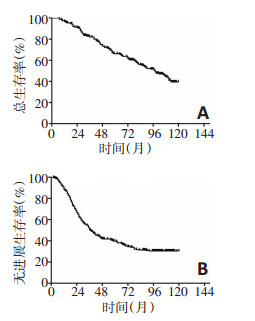Analysis of survival and prognostic factors of patients with intracranial ependymoma
-
摘要:
目的 研究影响颅内室管膜瘤患者生存和预后的相关因素, 为临床治疗提供理论依据。 方法 回顾性分析2008年1月至2018年1月中南大学湘雅医院收治的颅内室管膜瘤患者276例, 分析性别、年龄、肿瘤部位、肿瘤直径、手术切除程度、病理分级、Ki-67指数、术后是否放疗、术后是否化疗对颅内室管膜瘤患者总生存时间和无进展生存时间的影响。 结果 肿瘤部位、手术切除程度、术后是否放疗均能影响颅内室管膜瘤患者总生存时间和无进展生存时间(P<0.001), 并且是影响总生存时间(P<0.001, P<0.001, P = 0.002)和无进展生存时间(P<0.001, P<0.001, P<0.001)的独立因素; Ki-67指数是影响颅内室管膜瘤患者无进展生存的独立因素(P<0.001)。肿瘤位于幕上、Ki-67指数≥10%是提示预后不佳的独立危险因素(P<0.001), 肿瘤全切、术后行放疗是保护因素(P<0.001, P=0.001)。 结论 肿瘤部位、手术切除程度、Ki-67指数、术后是否放疗是响颅内室管膜瘤预后的独立因素, 尽可能的肿瘤全切和术后放疗有助于延长患者的无进展生存时间和总生存时间。 Abstract:Objective To study the factors affecting the survival and prognosis of patients with intracranial ependymoma. Methods From January 2008 to January 2018, the prognoses of 276 patients with intracranial ependymoma were analyzed using Log-rank and Cox model analysis.The variables included sex, age, tumor location, tumor diameter, resection extent, pathological grade, Ki-67 index, postoperative radiotherapy, and postoperative chemotherapy. Results Tumor location, resection extent, and postoperative radiotherapy could all affect the overall survival (OS) and progression-free survival (PFS) of patients with intracranial ependymoma (P<0.001) and independently affected the OS (P<0.001, P<0.001, and P =0.002, respectively) and PFS (P<0.001, P<0.001, and P=0.001, respectively). The Ki-67 index was an independent factor affecting PFS in patients with intracranial ependymoma (P<0.001).The supratentorial location and Ki-67 index ≥10% were independent risk factors indicating poor prognosis (P<0.001).Total resection and postoperative radiotherapy were protective factors (P<0.001 and P =0.001, respectively). Conclusions Tumor location, resection extent, Ki-67 index, and postoperative radiotherapy are independent factors affecting the prognosis of intracranial ependymoma.It is helpful to extend the PFS and OS of patients through complete tumor resection or postoperative radiotherapy. -
Key words:
- ependymoma /
- survival /
- prognosis /
- related factors
-
表 1 276例颅内室管膜瘤患者的一般资料

表 2 276例颅内室管膜瘤患者总生存率的单因素分析

表 3 276例颅内室管膜瘤患者无进展生存率的单因素分析

表 4 276例颅内室管膜瘤患者总生存率的多因素分析

表 5 276例颅内室管膜瘤患者无进展生存率的多因素分析

-
[1] Ostrom QT, Gittleman H, Liao P, et al.CBTRUS Statistical Report:Primary brain and other central nervous system tumors diagnosed in the United States in 2010-2014[J].Neuro Oncol, 2017, 19(Suppl 5):v1-v88. [2] Louis DN, Perry A, Reifenberger G, et al.The 2016 world health organization classification of tumors of the central nervous system:a summary[J].Acta Neuropathologica, 2016, 131(6):803-820. doi: 10.1007/s00401-016-1545-1 [3] Metellus P, Guyotat J, Chinot O, et al.Adult intracranial WHO grade Ⅱ ependymomas:long-term outcome and prognostic factor analysis in a series of 114 patients[J].Neuro Oncol, 2010, 12(9):976-984. doi: 10.1093/neuonc/noq047 [4] Ye J, Zhu J, Yan J, et al.Analysis on therapeutic outcomes and prognostic factors of intracranial ependymoma:a report of 49 clinical cases in a single center[J].Neurol Sci, 2015, 36(12):2253-2261. doi: 10.1007/s10072-015-2347-2 [5] Song SW, Dho YS, Kim JW, et al.Recursive partitioning analysis for disease progression in adult intracranial ependymoma patients[J].J Clin Neurosci, 2017, 46:72-78. doi: 10.1016/j.jocn.2017.08.056 [6] Merchant TE, Li C, Xiong X, et al.Conformal radiotherapy after surgery for paediatric ependymoma:a prospective study[J].Lancet Oncol, 2009, 10(3):258-266. doi: 10.1016/S1470-2045(08)70342-5 [7] Swanson EL, Amdur RJ, Morris CG, et al.Intracranial ependymomas treated with radiotherapy:long-term results from a single institution [J].J Neurooncol, 2011, 102(3):451-457. doi: 10.1007/s11060-010-0344-0 [8] Vanuytsel L, Brada M.The role of prophylactic spinal irradiation in localized intracranial ependymoma.[J].Int J Radiat Oncol Biol Phys, 1991, 21(3):825-830. doi: 10.1016/0360-3016(91)90704-8 [9] Kawabata Y, Takahashi J A, Arakawa Y, et al.Long-term outcome in patients harboring intracranial ependymoma[J].J Neurosurg, 2005, 103 (1):31-37. http://www.wanfangdata.com.cn/details/detail.do?_type=perio&id=ed3b2aeacff720cddac36719a071844a [10] Metellus P, Barrie M, Figarella-Branger D, et al.Multicentric French study on adult intracranial ependymomas:prognostic factors analysis and therapeutic considerations from a cohort of 152 patients[J].Brain, 2007, 130(5):1338-1349. doi: 10.1093/brain/awm046 [11] Vanuytsel LJ, Bessell EM, Ashley SE, et al.Intracranial ependymoma: long-term results of a policy of surgery and radiotherapy[J].Int J Radiat Oncol Biol Phys, 1992, 23(2):313-319. doi: 10.1016/0360-3016(92)90747-6 [12] Paulino AC, Wen BC, Buatti JM, et al.Intracranial ependymomas:an analysis of prognostic factors and patterns of failure.[J].Am J Clin Oncol, 2002, 25(2):117-122. doi: 10.1097/00000421-200204000-00003 [13] Metellus P, Figarella-Branger D, Guyotat J, et al.Supratentorial ependymomas:prognostic factors and outcome analysis in a retrospective series of 46 adult patients[J].Cancer, 2010, 113(1):175-185. doi: 10.1002/cncr.23530/full [14] Phi JH, Wang KC, Park SH, et al.Pediatric infratentorial ependymoma: prognostic significance of anaplastic histology[J].J Neurooncol, 2012, 106(3):619-626. doi: 10.1007/s11060-011-0699-x [15] Takami H, Graffeo C, Perry A, et al.Giant cell ependymoma of the lateral ventricle:case report, literature review, and analysis of prognostic factors and genetic profile[J].World Neurosurgery, 2017, 108: 997. http://europepmc.org/abstract/MED/28943417 [16] Wolfsberger S, Fischer I, Höftberger R, et al.Ki-67 immunolabeling index is an accurate predictor of outcome in patients with intracranial ependymoma[J].Am J Surg Pathol, 2004, 28(7):914-920. doi: 10.1097/00000478-200407000-00011 [17] Gornet MK, Buckner JC, Marks RS, et al.Chemotherapy for advanced CNS ependymoma[J].J Neurooncol, 1999, 45(1):61-67. doi: 10.1023/A:1006394407245 [18] Brandes AA, Cavallo G, Reni M, et al.A multicenter retrospective study of chemotherapy for recurrent intracranial ependymal tumors in adults by the gruppo italiano cooperativo di neuro-oncologia[J]. Cancer, 2010, 104(1):143-148. doi: 10.1002/cncr.21110/full [19] Rudà R, Bosa C, Magistrello M, et al.Temozolomide as salvage treatment for recurrent intracranial ependymomas of the adult:a retrospective study[J].Neuro Oncol, 2016, 18(2):261-268. doi: 10.1093/neuonc/nov167 [20] Liu AP, Shing MM, Yuen HL, et al.Timing of adjuvant radiotherapy and treatment outcome in childhood ependymoma[J].Pediatr Blood Cancer, 2014, 61(4):606-611. doi: 10.1002/pbc.24820 [21] Vitanovics D, Bálint K, Hanzély Z, et al.Ependymoma in adults:surgery, reoperation and radiotherapy for survival[J].Pathol Oncol Res, 2010, 16(1):93-99. doi: 10.1007/s12253-009-9194-5 -




 下载:
下载:




